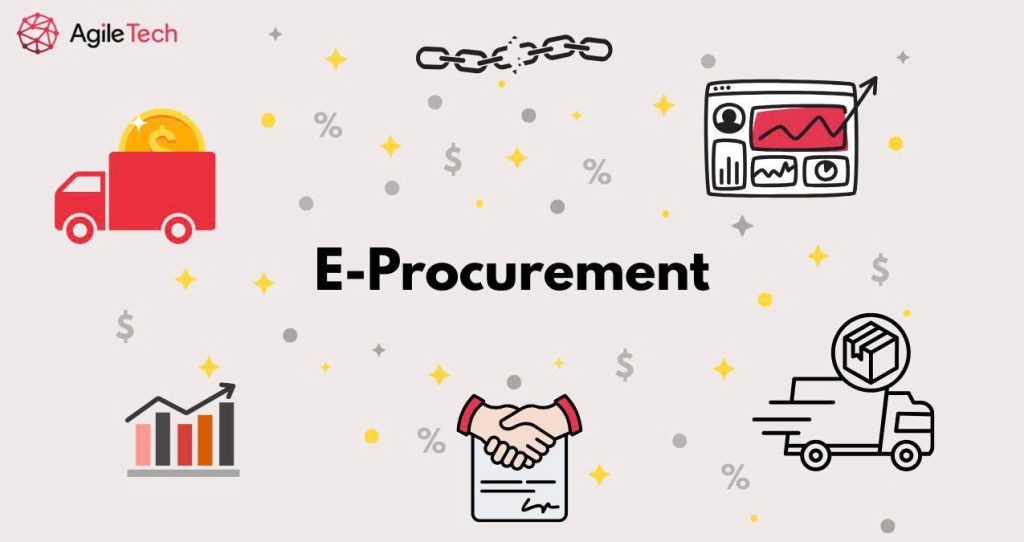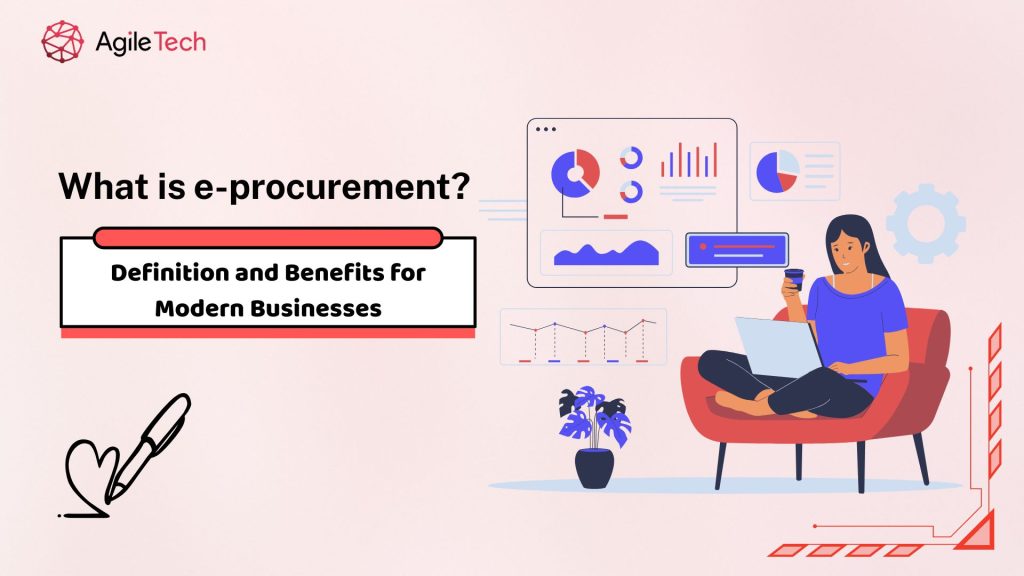What is e-procurement? Proven Definition and Key Benefits [2025]
As businesses grow and competition becomes increasingly fierce, manual procurement processes become major obstacles. To overcome this, e-procurement was introduced as a modern replacement. It brings all purchasing activities into a digital environment, helping organizations optimize costs, eliminate hidden inefficiencies and give leaders real-time data for more accurate decision-making.

1. What is e-procurement?

E-procurement or electronic procurement, is a system that digitizes and automates the entire procurement process within an organization. It covers every stage from identifying requirements and evaluating suppliers to ordering, receiving, payment, spend analysis and compliance management. All of these activities are centralized on a single online platform.
Beyond reducing costs, shortening approval cycles and minimizing errors, e-procurement also ensures transparency, protects data security and enables data-driven decision-making. It provides a solid foundation for digital transformation and strengthens competitive advantage.
In contrast, traditional procurement relied on paperwork, emails, scattered Excel sheets, which made the process slow, error-prone and hard to manage. With e-procurement, purchase requests are submitted, approved online, suppliers upload quotations directly into the system, contracts, invoices and payments can be stored and retrieved instantly. The result is faster workflows, greater transparency and lower costs.
Read more: What is Procurement Software? Complete Guide to Modern Procurement Solutions
2. The Importance of E-Procurement – Why It Matters for Businesses?
E-procurement is not merely a digital tool to automate purchasing processes, it is a differentiator in the competitive capability of modern enterprises. Implementing e-procurement helps organizations address challenges in cost, transparency and efficiency, while also delivering long-term strategic benefits.
2.1 Cost Savings
E-procurement eliminates many hidden costs that exist in traditional procurement workflows. By moving to a digital system, businesses can cut expenses related to printing, paper storage, courier services and manual data entry.
More importantly, the platform consolidates purchasing needs across departments. This enables bulk buying, stronger collective bargaining power with suppliers, creating opportunities for better pricing, volume discounts and long-term contracts.
Automated data reconciliation further reduces invoice mismatches, duplicate orders and human errors that often cause unnecessary spending. Over time, these improvements add up to significant cost savings that directly strengthen the company’s bottom line.
2.2 Transparency and Stronger Compliance
One of the most significant advantages of e-procurement is its ability to deliver full transparency across the entire procurement lifecycle. Every request, approval, purchase order, payment is captured in an electronic trail, making it easier for both internal teams and external auditors to verify transactions.
This traceability not only minimizes the risk of fraud but also ensures compliance with financial governance standards, corporate policies and regulatory requirements. Organizations in highly regulated industries such as healthcare, finance, government especially benefit from this stronger compliance and risk management.
In addition, management gains real-time visibility into spending behavior, which supports stricter policy enforcement and greater accountability.
2.3 Shortened Approval Cycles and Higher Productivity
Traditional procurement processes often face bottlenecks such as paperwork delays, unavailable approvers or manual verification. With e-procurement, approvals are digitized and executed anytime, anywhere, supported by automated notifications and role-based access to ensure requests reach the right stakeholders promptly.
This not only shortens the cycle from requisition to purchase order but also reduces administrative workload. It allows procurement teams to focus on strategic tasks such as spend analysis, supplier management and process optimization. As a result, businesses can operate with greater speed and efficiency.
2.4 Data-Driven Decision Support
A key long-term value of E-procurement is its ability to generate and analyze large volumes of data. The system tracks spending trends, supplier performance, savings from negotiations and compliance rates. These insights e-procurement are presented through reports and dashboards that help decision-makers identify cost-saving opportunities, manage risks and assess supplier reliability.
Over time, these insights form the basis for efficient and sustainable procurement strategies. Companies can address underperforming suppliers, renegotiate contracts or diversify vendor portfolios to reduce dependency risks. By leveraging data-driven insights, executives align procurement objectives more closely with broader business goals such as sustainability, innovation and long-term growth.
3. How Does E-Procurement Work?
E-procurement is a system composed of tightly connected processes that form a closed procurement lifecycle. Each process plays its own role while complementing the others, ensuring procurement activities remain transparent, efficient and measurable.

3.1 E-informing
E-informing serves as the foundation of the entire e-procurement system. This step involves sharing and providing essential procurement information such as purchasing policies, internal procedures, product/service catalogs, approval authorities and supplier selection criteria.
With e-informing, all departments within the organization access information under a unified standard. This eliminates situations where different teams apply inconsistent rules, which could otherwise lead to conflicts or misunderstandings. Transparent communication of policies also enhances compliance and reduces management risks.
3.2 E-sourcing
E-sourcing is the stage where detailed purchasing requirements are defined and suitable suppliers are identified. Organizations must clarify factors such as product type, quantity, quality standards and delivery schedules. The e-procurement system then supports a pre-qualification process to filter out unqualified suppliers at an early stage.
3.3 E-tendering
Instead of manually issuing requests for quotation (RFQs) via email, e-tendering allows organizations to publish and manage RFQs online. Suppliers respond directly through the system using standardized forms, making comparison and evaluation much easier.
This brings two clear advantages: organizations save significant manual processing time and the supplier selection process becomes more transparent and fair. There is no longer a risk of lost information or biased evaluations, since all transactions are digitally recorded and retrievable at any time.
3.4 E-auctioning
E-auctioning is a real-time online bidding process where suppliers compete directly on the e-procurement platform, offering their most competitive prices and terms to win the contract.
This gives businesses two key benefits: better pricing and clearer delivery conditions. It also encourages suppliers to continuously improve service quality to maintain their advantage in future tenders.
3.5 E-ordering & Payment
Once a supplier is selected, the e-procurement system automatically generates a Purchase Order (PO) and shares it with all relevant parties. Delivery and receipt of goods are also recorded directly in the system, ensuring synchronization between the purchase order, received goods and payment invoices.
This mechanism prevents payment risks such as paying for incorrect quantities or settling invoices before conditions are met. In addition, electronic payments shorten processing times, improve cash flow and strengthen supplier relationships.
3.6 Analytics
Analytics is the critical step that turns transaction data into strategic insights. The e-procurement system provides detailed reports on departmental spending, supplier performance, cost savings achieved and market trends.
4. Challenges in Implementing E-Procurement
There is no denying that e-procurement offers outstanding benefits. However, implementing such a system also comes with challenges. Organizations must identify these potential obstacles in advance to prepare appropriate plans and deployment roadmaps.
4.1 Legacy System Integration
Many organizations have relied on ERP or CRM systems for years, often with complex processes and data structures. Integrating e-procurement into these existing systems can be difficult. If not managed properly, it may lead to duplicated or inconsistent data or even disrupt business operations. This is one of the most significant technical barriers, especially for enterprises with long-standing IT infrastructures.
Learn more: ERP Procurement: Optimize ERP System Purchasing with Clear Steps & Roles
4.2 Employee Training & Adoption
Another challenge comes from the human factor. Employees who are accustomed to manual workflows or Excel often resist change. Adapting to a completely new platform may create resistance, resulting in underutilization of the system. This directly impacts efficiency and undermines the original goals of the project.
4.3 Initial Investment Costs
Implementing e-procurement requires a considerable budget, including software, infrastructure, system integration, training and maintenance costs. For small and medium-sized enterprises (SMEs), this upfront investment can be a significant barrier, causing delays or hesitation in adoption.
4.4 Supplier Onboarding
E-procurement only delivers real value when both the business and its suppliers actively participate. However, many suppliers, especially small businesses are not familiar with digital platforms. This creates challenges in data exchange, order processing and maintaining seamless workflows, ultimately reducing the overall effectiveness of the system.
Discover more: How to Implement A Procurement System: Key Steps & Tips for Success
5. Real-World Applications of E-Procurement
5.1 Office Supplies, Logistics and Support Services
In daily operations, organizations often need recurring purchases such as office supplies, IT equipment, cleaning, maintenance or transportation. Each order may seem small, but together they add up to significant annual costs.
When handled manually, these purchases can result in uncontrolled spending, duplicate requests and difficulties in tracking invoices. With e-procurement, businesses can consolidate demand across departments, automate approvals and gain real-time visibility into expenses. This prevents budget leakage, strengthens negotiation power with suppliers and simplifies auditing.
5.2 Manufacturing
The manufacturing industry is where e-procurement shows the strongest impact, as procurement directly influences production schedules. Manufacturers depend on a steady supply of raw materials, components and maintenance services and any disruption can lead to costly downtime. Traditional procurement often struggles to align purchasing with production planning, causing stock outs or excess inventory.
With e-procurement, purchase orders are automatically triggered when inventory falls below threshold levels, supplier quality is evaluated using standardized criteria, and delivery performance is closely monitored. As a result, manufacturers achieve just-in-time production, reduce capital tied up in inventory and strengthen relationships with reliable suppliers.
5.3 Retail & Trade
Retailers and trading companies handle thousands of products and suppliers, so accuracy and speed are critical to competitiveness. Manual procurement systems, however, are prone to errors, pricing discrepancies, and missed delivery schedules – especially with high transaction volumes. E-procurement addresses these challenges by centralizing supplier catalogs, standardizing quotation formats and recording every procurement activity in real time.
This gives retailers full transparency into vendor performance, delivery schedules and stock replenishment cycles. The result is faster procurement workflows, fewer stockouts, more accurate demand forecasting and better cost control across multiple outlets or branches.
5.4 Service Industries
In service-based industries such as IT outsourcing, consulting, healthcare, or hospitality, procurement mainly revolves around contracts and service-level agreements (SLAs). Without a centralized system, organizations struggle to compare providers, monitor performance and ensure compliance. E-procurement platforms solve these challenges by storing all contracts and SLAs in a single repository, automating renewal reminders and providing analytics for cost benchmarking.
This enables businesses to track supplier performance more effectively, renegotiate terms using data-driven insights and control operational costs while maintaining transparency. For service industries, it translates into stronger governance, higher efficiency and more resources dedicated to core business activities.
6. AgileTech – Your Trusted Partner for E-Procurement Solutions
With more than 10 years of experience in software development, Agiletech provides customized e-procurement solutions designed to fit the unique needs and scale of each business. Whether you are managing a large manufacturing enterprise, operating a multi-branch retail system or expanding in the service sector, the AgileTech team builds flexible, scalable and cloud-optimized solutions.
One of our key differentiators is delivering high-quality human resources. Our AgileTech experts not only develop e-procurement software but also accompany clients throughout the entire implementation journey from requirement analysis, solution design, ERP/CRM integration to training and post-deployment support.
Let AgileTech become your trusted partner in digital e-procurement transformation. Discover how we turn complex processes into streamlined, transparent and strategically valuable solutions for your enterprise.
Explore: Our Successful Case Studies!
7. Conclusion
E-procurement is no longer just a supporting tool – it has become a strategic advantage for modern businesses. By digitizing and automating procurement, companies save costs, improve compliance and strengthen competitiveness in the digital era.
For organizations that want to stay ahead, adopting e-procurement is not optional but essential. The key is choosing the right technology partner to ensure smooth implementation, scalability and long-term success.
With proven expertise and tailored solutions, AgileTech is ready to support your business in its digital procurement transformation. Contact us today to unlock the full potential of e-procurement for your enterprise.